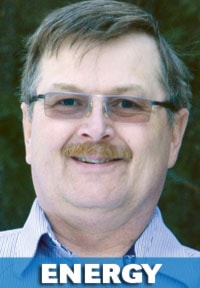Biomass is defined as “biological materials from living or recently living organisms.”
Gasification is the process of heating carbonaceous materials to give off hydrogen, carbon monoxide, and carbon dioxide.
Any carbon bearing material, be it coal, peat, wood chips, or simply plant matter can be converted into syngas.
The gasification process discovery is credited to the Scottish engineer William Murdoch in 1790 when he produced syngas from coal and used it for lighting his home.
During both the great wars, creative minds would run their vehicles with syngas using a wood gas generator called a Gasogene.
By 1945, an estimated nine million vehicles ran on syngas around the world.
Wood gas technology has not been forgotten or ignored.
Pulp mills and sawmills around the world use biomass to make syngas to power generators and supply electricity for the grid.
The process is relatively simple.
The “biomass” feedstock is heated to 700-plus degrees C without actual combustion.
A very controlled amount of oxygen and or steam is introduced into the mixture to form a synthesized gas referred to as syngas.
This syngas is then scrubbed to remove impurities, dust, sulphur, carbon particles, etc., where it then can be used in internal combustion engines or turbines.
Gasification is not limited to simply driving engines. Using chemical process like the Fischer-Tropsch process, syngas can be converted into diesel fuel or, using the Sabatier reaction, it can be converted into methane gas.
These products can then be used as a feedstock to produce other “drop in” fuels like ethanol or base materials for petrochemicals.
Not only for vehicles, Gasogene technology can be used to provide electrical power for remote locations.
One biomass gasification generator is being built in California and has sold units to numerous developing nations and university research facilities.
The 20 kW plant manufactured by All Power Labs uses a multistage downdraft gasifier to produce syngas and with computerized controls, it provides electricity with a reasonable purchase cost of $1.25 a watt.
This places it in the “price competitive range” with conventional generator sets.
Here in Alberta, biomass generally refers to wood chips and our biomass co-generation plants are tied in with the pulp mills in Whitecourt, Hinton, and Grand Prairie, or with sawmills in Drayton Valley, all which have an adequate feedstock of waste materials.
Alberta has nine biomass electrical generation plants spread around the province producing some 389 megawatts of electrical power.
These biomass cogeneration plants are considered sources of renewable energy as the wood chips they consume would normally be landfilled and, of course, trees like the aspen repopulate on their own rapidly.
Biomass is not limited to wood chips, although in most parts of the world they are the most common; walnut shells, coconut husks, corn cobs, and palm kernel shells are options in areas where they can be found in abundance.
Those wood chips you used for mulch around your trees and in your garden are not the waste products most imagine.
Lorne Oja is an energy consultant, power engineer and a partner in a company that installs solar panels, wind turbines and energy control products in Central Alberta. He built his first off-grid home in 2003. His column appears every second Friday in the Advocate. Contact him at: lorne@solartechnical.ca.
